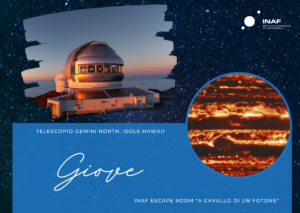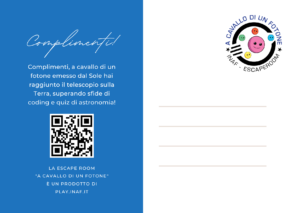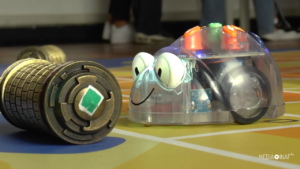 On board a photon is the Inaf Escape Room presented at the 2022 Science festival in Genova. It is an interactive experience, which allows you to take part in the journey of photons – light particles – from the depths of the Sun, where they start their adventure, through the planets and other celestial bodies of the Solar system, all the way to the telescopes of astronomers who, from the Earth, observe these bodies in order to study them in detail, understand how they work and take beautiful pictures of them.
On board a photon is the Inaf Escape Room presented at the 2022 Science festival in Genova. It is an interactive experience, which allows you to take part in the journey of photons – light particles – from the depths of the Sun, where they start their adventure, through the planets and other celestial bodies of the Solar system, all the way to the telescopes of astronomers who, from the Earth, observe these bodies in order to study them in detail, understand how they work and take beautiful pictures of them.
In line with the main theme of the festival – Languages – the challenges and the clues to pass various tests will be provided through a particular language: the one of computational logic and programming. In order to exit the Escape Room, participants should put their logical skills to work through the practice of unplugged coding (i.e. programming without the use of digital devices) supported by small robots.
The time envisaged in order to get out of the Escape Room is about 60 minutes.
In theory, up to eight teams can take part in the game. Each team should be marked by a different colour. However, we recommend limiting the number of teams to 4-5 (with about 4-5 participants each).
First challenge: the Sun
Step 1: Inside the Sun
We start with the following video (in italian, the english version will available soon), which tells us what happens to photons when they are produced by reactions of nuclear fusion inside the Sun, and then along the path awaiting them before they are able to leave the Sun, a path which takes them an average of millions of years to complete.
Step 2: Leaving the Sun
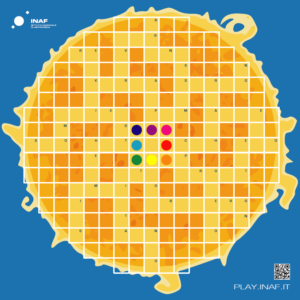
This challenge takes place on a large Sun-shaped labyrinth-carpet. In order to get out of the labyrinth, i.e. emerge from the depths of the solar interior up to the surface of the Sun, you need to program the robot-photon (a Bee-Bot, or Blue-Bot) following the instructions contained in the Universal Move Card in the form of commands written in programming language. The groups should place the robot-photon upon one of the 8 starting squares, the one corresponding to the colour of their team.
In order to overcome the challenge, the robot-photon must be given the right sequence of commands, conceived as starting from the Universal Move: if there is space in front of your robot-photon, then it should go forward. Otherwise, it will have to turn right or, if there is no space on the right, it will have to turn left, until it reaches the surface of the Sun. Turning right or left means rotating the robot-photon by 90 degrees respectively clockwise or counter-clockwise, while staying on the same cell of the labyrinth.
Step 3: The first “code” – hidden in the Cryptex
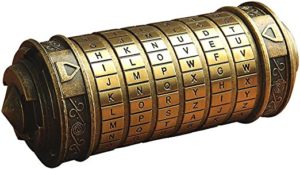
At the end of the various paths in the Sun-labyrinth there is a Cryptex (eight Cryptexes in all, one for each path). Well known to fans of the Da Vinci Code, the Cryptex is a cylinder bearing letters of the alphabet engraved upon a series of moving rings. It works like a combination lock: if the letters form the correct combination, the cylinder opens.
How will the various groups discover the “code”, i.e. the right combination of letters in order to open the Cryptex?
Second challenge: the planets
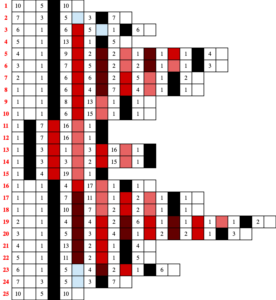
Step 4: Pixel Art
By opening the Cryptex with the correct combination of letters, each group will extract a sheet containing another “code”, which is different for each group. This code is a grid of numbered and colored boxes.
With this code, they will have to go to the Pixel-Art stations and use this technique of unplugged coding, coloring (while following the indications in the code) a squared sheet with the supplied pencils, so as to discover their destination in the Solar System. After coloring the sheets with Pixel Art, the various groups will disclose the picture of a planet. Each group will find the picture of a different planet, and will have to find the station related to that planet inside the room.
Step 5: Arrival to the Planet: Quiz and Treasure Hunt
Near the station of each planet, participants will find a picture of the planet, which will allow them to realize that they reached the right place. Each group, near the corresponding planet, will also find a treasure box closed with a padlock, and a series of Quizzes related to that particular planet (or dwarf planet, as in the case of Pluto). By correctly answering the questions of the quiz, participants will be able to draw another “code” which will allow them to open the padlock.
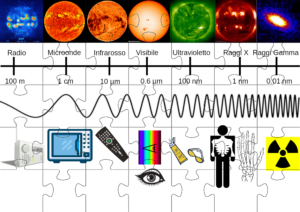
Step 6: Inside the Treasure Box: the Puzzle
Once teams open the Treasure Box, they will find a series of mysterious objects: pieces of a puzzle, a normal flashlight (visible light), a flashlight with ultraviolet light, a CD and an eraser in the shape of a planet.
By combining some of these objects, it will be possible to reveal yet another “code”…
Will our heroes overcome this challenge?
Third challenge: the Earth
Step 7: Towards the Earth
The “code” discovered by using the objects inside the treasure box is the key to get to the Earth. But not anywhere on the Earth: each photon, after having been reflected by one of the other planets of the Solar System, will reach our planet in a precise point, near a telescope.
Each group will use the world map with a series of telescopes, which is placed near the Earth station, and use the new code in order to find the right telescope for their own photon.
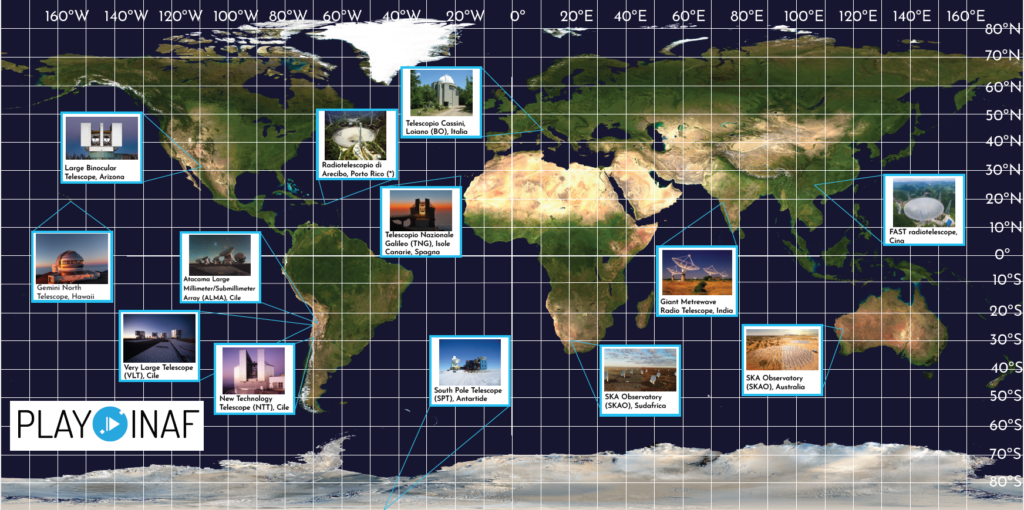
Step 8: Dodge the last dangers: the labyrinth of the Ozobots
Once they discover their own destination on the Earth, all teams will approach the Ozobot station in order to reach their own telescope. At this point, each group will receive a sheet with the path of the maze and four markers. There will also be a legend explaining how to colour the squares and program the Ozobot on each labyrinth-sheet.
Each group shall colour the various white squares in the layirinth to program the Ozobot, so that it reaches the right telescope according to the above-mentioned Ozobot rules, without getting “trapped” by a series of dangers (atmospheric clouds, or satellites in a low orbit) encountered along the way.
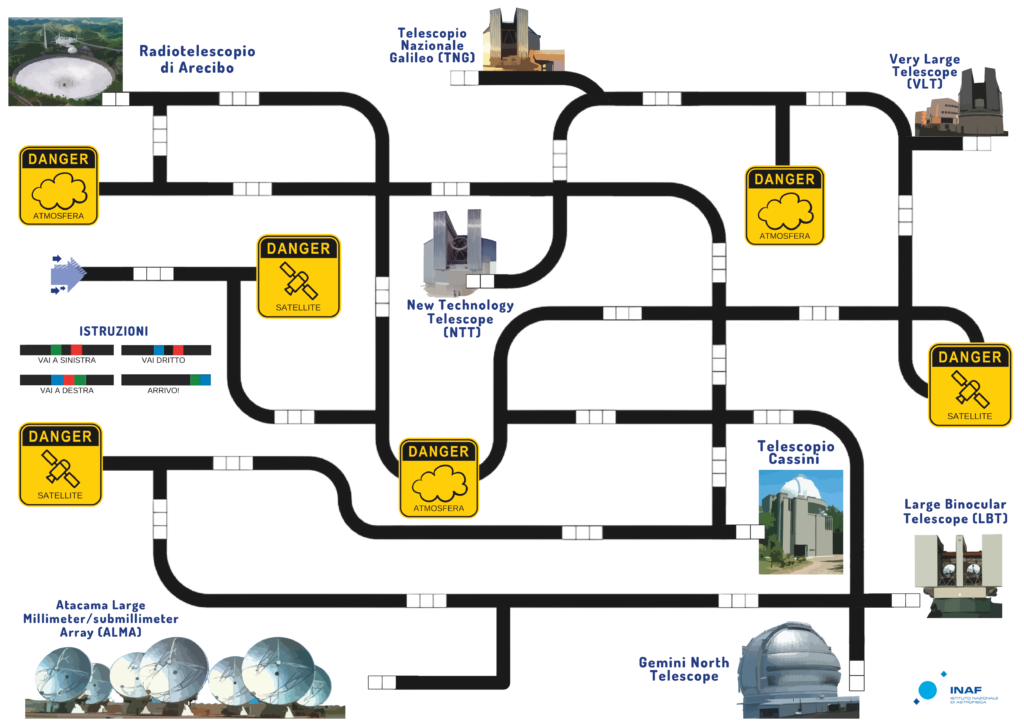
Once they have coloured the labyrinth, each group will give the sheet to the facilitator, who will verify whether the path is right, by placing the Ozobot on the arrow, activating it and waiting until it reaches its destination (and checking on the table that the team is going to the telescope with the right colour).
If the Ozobot reaches the right telescope, the group has passed the test and completed the Escape Room: congratulations! The group will be given a key: the keyring bears the picture of the planet explored by the group.
Exit from the Escape Room
Step 9: Congratulations, you are out of the Escape Room!
With the key they have received, all groups will open a Book-Treasure Chest inside a basket and receive the award: a postcard with the picture of the explored planet and of the telescope that obtained it.
You can find a complete guide to the Escape Room here (PDF, 3MB, in Italian).
List of files to print to create the Escape Room: (some of the graphics are in Italian, they will soon become available in English)
- Sun carpet
- Universal Move Card
- Planet colour codes
- Pixel art squared sheet
- Planet quiz
- Puzzle
- Printable planet pictures 30x30cm (Mercury, Uranus and Neptune)
- Printable planet pictures 34x34cm (Mars, Jupiter and Saturn)
- Printable planet pictures 38x38cm (Venus, Earth and Pluto)
- Sun rollup
- Mercury rollup
- Venus rollup
- Earth rollup
- Mars rollup
- Jupiter rollup
- Saturn rollup
- Uranus rollup
- Neptune rollup
- Pluto rollup
- Ozobot labyrinth
- Earth map with telescopes
- Mercury postcard
- Venus postcard
- Mars postcard
- Jupiter postcard
- Saturn postcard
- Uranus postcard
- Neptune postcard
- Pluto postcard
List of material to set up the Escape Room:
- 8 cryptexes
- 8 4-digit padlocks
- 8 treasure chests
- 8 CDs or DVDs
- 8 regular flashlights
- 8 UV flashlights
- UV pen
- BeeBot or BlueBot (we used six)
- Ozobot (at least one)
- set of colored pencils (for pixel art)
Note: the files and materials listed here are the ones we used to set up the Escape Room version that was presented at the Science festival in Genova. If you wish to propose a less expensive version of the Escape Room, you could print files on different formats. For example, you could: replace the large 3-meter carpet a similar grid created on the floor with paper tape, use regular 6-digit padlocks instead of cryptexes (replacing the letters on the labyrinth with the combination numbers), print the rollup content on A4 paper sheets.
This escape room was developed by Claudia Mignone, Federico Di Giacomo, Laura Leonardi, Maria Teresa Fulco, Silvia Galleti and Maura Sandri. The picture of the Sun, used as a background in the labyrinth was realized by Barbara Olmi. Image credits: Arecibo Observatory (UCF)/NASA/Edgard G. Rivera-Valentín (Lunar and Planetary Institute)/USRA); Pedro Machado, et al. 2022; ESO; International Gemini Observatory/NOIRLab/NSF/AURA, M.H. Wong (UC Berkeley) et al.; Cassini Telescope INAF-OAS; LBT, E. Pinna (INAF-OAA) et al.; ESO/P. Weilbacher (AIP); NRAO/AUI/NSF.
Watch the video news reel by Media Inaf Tv (in Italian):

